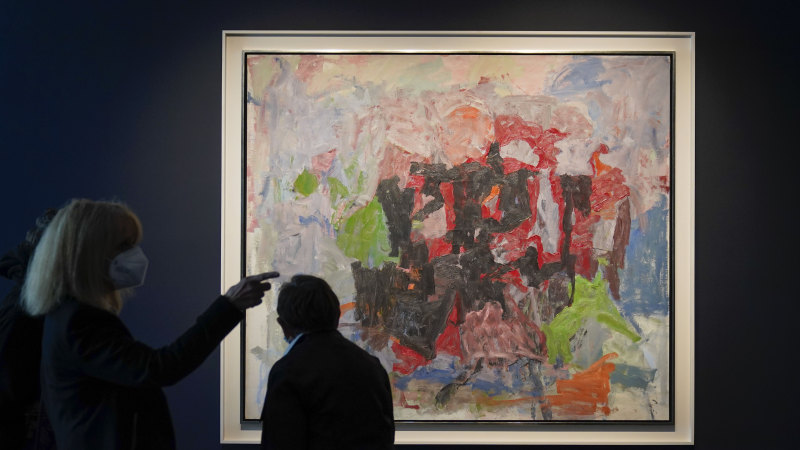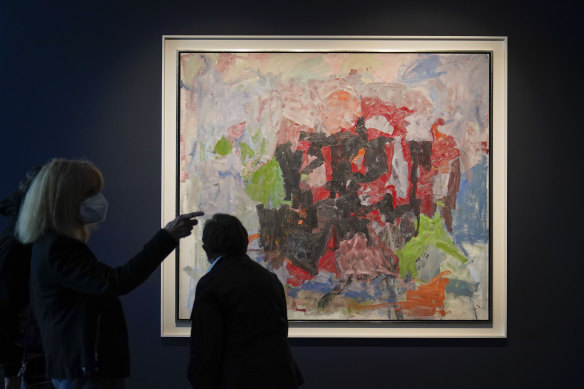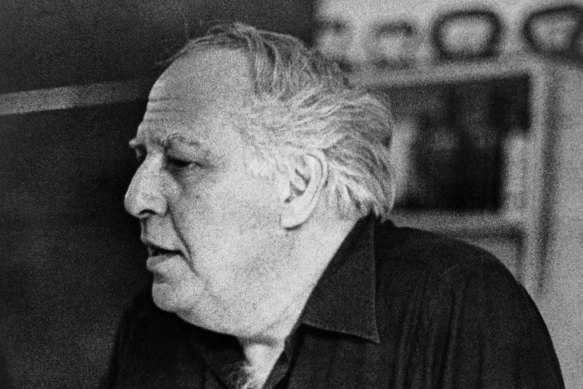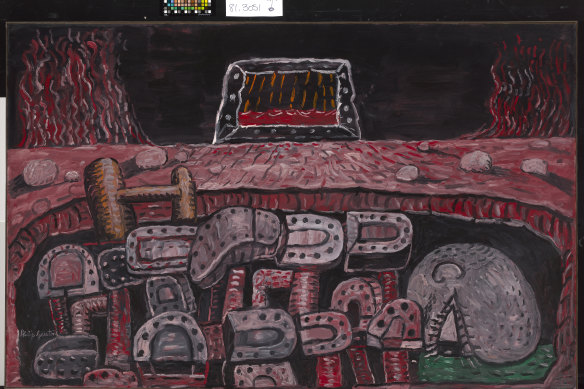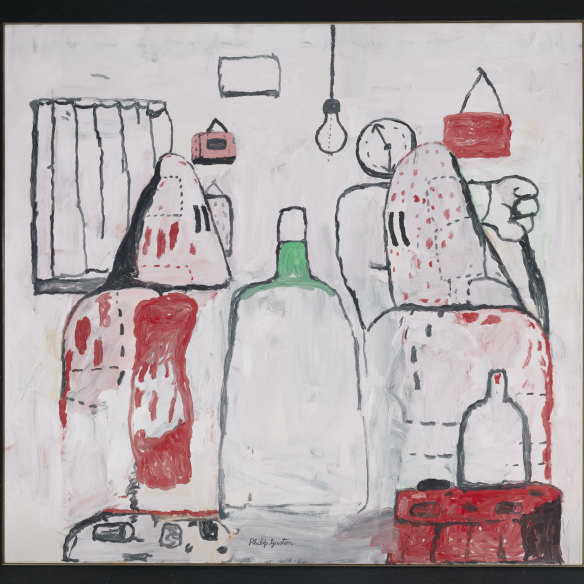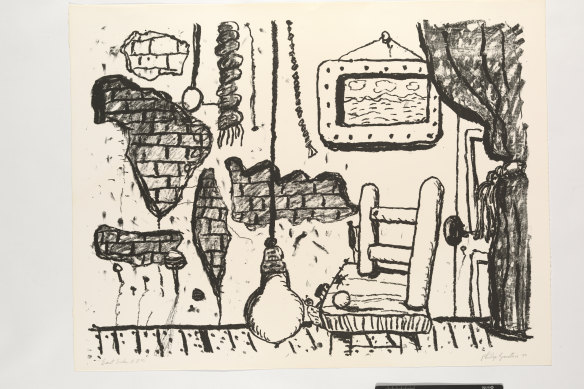By John McDonald
Philip Guston’s Nile on display at Sotheby’s in New York.Credit: AP Photo/Seth Wenig
Save articles for later
Add articles to your saved list and come back to them any time.
We are forever hearing about artists whose work is “challenging” and “subversive”, usually in the context of some prestigious museum survey. In the pageant of contemporary art, the oppositional artist has become a stock figure. They know exactly what buttons to push to win the esteem of institutions that passionately need to be seen as hip and progressive – even if nobody goes to their boring shows.
Consider then the case of Philip Guston (1913-80), one of the truly great artists of the late 20th century, who managed to alienate friends and admirers with a single exhibition at Marlborough Gallery, New York in 1970. Although his reputation would recover and flourish, 40 years after his death, Guston’s work has generated a whole new set of problems for four major museums hosting a retrospective.
By 1970, Guston was a fully-fledged member of the Abstract Expressionist club, along with iconic figures such as Jackson Pollock, Willem De Kooning and Mark Rothko. Known for the tremulous abstractions he had been painting since the early 1950s, the Marlborough show was a complete departure – and a debacle. Guston’s new work was not only figurative but filled with crudely cartoonish images of Ku Klux Klansmen. To those who believed abstraction represented spiritual progress in art, Guston had declared himself an apostate.
Artist Philip Guston, who died in 1980.
Major critics, including Robert Hughes, wrote damning reviews. Hardly anything was sold. Close friends, such as the composer Morton Feldman, would never speak to Guston again. It would be 10 years until their next encounter, when Feldman turned up to say Kaddish – the Jewish prayer for the dead – as requested in the artist’s will. Neither man was at all religious, but sombre occasions call for ceremony.
The one major commentator who responded sympathetically to the Marlborough show was Harold Rosenberg. The only artist who took Guston’s side was De Kooning, who praised him for his bravery and declared that his true subject was “freedom”.
I’ve often wondered how I would have reacted to this exhibition had I been around in those days. Would I have embraced it like De Kooning, or rejected it like Bob Hughes? I honestly don’t know. It’s too easy to be wise in hindsight.
What I do know is that by 2020 those crude, cartoonish paintings were among the most influential works of our time. As the cult of abstraction waned and figuration returned, Guston was no longer viewed as an outcast, but a prophet. Over the final decade of his life, he would paint with incredible verve. His ugly-beautiful images are full of pathos, anger and scabrous satire. They were tragic and comedic, stunningly banal and deeply metaphysical.
One might expect a retrospective held at the Boston Museum of Fine Arts, the Houston Museum of Fine Arts, the National Gallery of Art Washington D.C. and Tate Modern in London, to put the sealer on Guston’s fame. Instead, the show would become caught up with America’s fraught, racially divisive political climate. Now Guston’s Klansmen – those hooded buffoons that encapsulated everything he despised – are viewed with paranoid suspicion.
He smoked continuously, was a functioning alcoholic, and ate all the wrong food.
After George Floyd’s death and the Black Lives Matter protests, museum authorities felt audiences might not appreciate Guston’s satire and indeed be traumatised by the sight of so many hooded figures. It was proposed to postpone the show until 2024, although the final delay would be closer to 18 months. When the exhibition debuted in Boston it was accompanied by a whole bundle of trigger warnings, and a statement on “Emotional Preparedness”. The assumption seemed to be that audiences were so stupid they would see an image of a Klansman and assume the artist was a White Supremacist.
Thankfully, by the time the show reached the National Gallery of Art, where I saw it last week, the PC trimmings had been toned down. By now the museums would probably like us to forget the display of hypersensitivity that almost derailed the exhibition.
The content of the show exposes the absurdity of the hand-wringing, as it charts Guston’s evolution from a left-wing activist who painted murals during the Great Depression, to a creator of delicate, suggestive abstractions, and finally, one of the most radical image-makers in world art. The journey of Guston’s life was a long search for self-awareness, as he sought to balance his private anxieties with a social conscience that gnawed at him relentlessly.
To understand Guston, it helps to know that he was prone to manic binges of work and ecstatic bursts of emotion. He smoked continuously, was a functioning alcoholic, and ate all the wrong food. As this seemed to be part of his very DNA, he refused to change his ways even after a heart attack. His lifestyle was more like a death wish. In 1980, he dropped dead at the dinner table.
Guston was born in Canada into an impoverished Jewish family of Eastern European origins. A move to San Francisco made work even harder to find, prompting his father to hang himself. It’s part of the artist’s legend that he discovered the body, but this is by no means certain. The young Guston was a compulsive artist, largely self-taught. He travelled with friends to Mexico to paint a gigantic mural, in which the Klansmen made an early appearance as villains.
In San Francisco he met poet and artist, Musa McKim, who would become his wife and lifelong muse. He claims to have changed his name from Goldstein to Guston to make himself more acceptable to Musa’s parents, but it was a common enough tactic in a society in which anti-Semitism put up many invisible barriers for an aspiring artist.
Philip Guston’s Pit (1976) is at the National Gallery of Australia.
Guston’s early work is politically charged and conspicuously “literary”. His closest friends were writers and poets, and his reading encompassed everyone from Kierkegaard to Kafka to Isaac Babel. His greatest artistic influences were Italian, from Piero della Francesca to Giorgio de Chirico. There is a case to be made that Guston was always a “metaphysical” artist in the wake of de Chirico, as he thoroughly understood the dumb pathos of objects and the greater meanings they assume in art and life. Where de Chirico might paint a glove, or a biscuit, Guston would paint a book, a sandwich, a light bulb, a shoe or a nail.
After producing murals for Roosevelt’s Works Progress Administration, Guston embarked on large, complex pictures such Martial Memory (1941) and If This be Not I (1945), demonstrating a mastery of composition and technique that he would gradually un-learn. These paintings use images of children to tease out the incipient violence that underlies war and social injustice.
In the early 1950s, living in Woodstock, in upstate New York, Guston responded to pressure from friends such as Pollock, to embrace the Abstract Expressionist ethos. Standing so close to the canvas he couldn’t see what a work looked like in its entirety, he began to create delicate, low-keyed pictures in which one brushstroke connected to the next with a kind of nervous electricity, as patches of colour were laid one on top of another. Today these paintings are often viewed as secondary to Guston’s achievement, and vaguely dishonest, but works such as Voyage (1956) or Native’s Return (1957), are as masterful in their own way as anything that came later. The busy surfaces charged with feeling remain a mesmeric experience for the viewer.
In the studio, Guston never seemed to do anything by halves, and gradually the paintings began to change. His palette fixated on shades of grey and pink, with dark, looming shapes appearing beneath the furious brushstrokes. These shapes were clearly heads, most likely disguised self-portraits. They testified to the internal pressure Guston felt to reintroduce recognisable imagery into his work. He showed his hand with titles such as Head I (1965), and Painter III (1963), revealing his close identification with a favourite quote from Leonardo da Vinci: pittura è un cosa mentale (“painting is a mental thing”).
In the mid-to-late 60s, Guston became more irascible in his public statements and lectures. In 1958 he wrote: “Painting is a clock that sees each end of the street as the edge of the world.” As early as 1960, he had claimed to find no freedom in abstraction, and considered his pictures to be a kind of figuration. “Painting is impure,” he said. “…we are image-makers and image-ridden.”
The catalyst was the year 1968, with the Vietnam War, and the assassinations of Martin Luther King and Bobby Kennedy. When the hated Richard Nixon became President the following year, Guston could no longer bring himself to paint in an abstract manner. “I got tired of all that purity,” he said. Everywhere he saw violence and social hatred, fuelled by political opportunism. Sound familiar? This is one reason the exhibition is called Guston Now.
Philip Guston’s Bad habits (1970).
Guston would work off his disgust with Nixon in two epic sequences of cartoons, in 1971 and 1975. The National Gallery is displaying these savage, brilliant drawings in a parallel show called Poor Richard. Guston’s graphic shorthand transforms Nixon’s nose and jowls into a penis and scrotum. Spiro Agnew is a conehead with bolts in his neck, while Henry Kissinger is nothing but a pair of horn-ribbed glasses. The artist would chew over his political frustrations with novelist, Philip Roth, a friend and neighbour in Woodstock, who wrote his own Nixon satire, Our Gang (1971).
Out of this anger would come the Marlborough show, in which Guston broke ranks with his peers, to celebrate painting’s connections with the messiness and squalor of everyday life.
Those works that left everyone dumbfounded may be read in many ways. The wrong way is to see Guston as a kind of Pop artist. He disliked this art so much that he quit Marlborough when the gallery held a Pop show. Andy Warhol said “Pop is liking things”, and Guston firmly believed such an uncritical acceptance of a given reality had no place in art. “Don’t paint to be loved,” he told a group of students.
The right way is to see the Klansmen paintings as allegories, although they do not boil down into simplistic, tidy stories. One might read all of Guston’s late work as broadly allegorical – i.e. as images with hidden meanings even the artist himself could fully explain. The straightforward interpretation of the Klansmen is that they are symbols of social iniquity, of the racism and hatred embedded in the heart of American life. The Klansmen are both evil and comical, killer clowns that cruise around in silly jalopies, leaving their victims stuffed into trash cans, then pleading innocence. Yet they are also portrayed as artists.
The key painting was The Studio (1969), in which a Klansman sits at an easel painting a self-portrait. The cigarette protruding from his hood proclaims that it’s Guston himself. He is implying that to be a passive actor in society is to be in collusion with crime and injustice. It’s a lightly hooded attack on the grand cosmic indifference of Abstract Expressionism, the first avant-garde school of art the American government felt happy to send around the world as a symbol of freedom.
Guston is saying “mea culpa”, but also pointing a finger in a big Mickey Mouse glove, at his peers and audience. That pointing finger is featured in multiple paintings, although the Klansmen pay little attention. It’s the same sovereign contempt for the rule of law one finds in a nation remade in Donald Trump’s image. One can barely imagine what Guston would have made of this one-man crime spree disguised as a politician.
Philip Guston, Gemini G.E.L., Room (1980).
A key painting from the Marlborough show, Bad Habits (1970) is in the collection of the National Gallery of Australia, along with a later masterpiece, called Pit (1976), which features a mass of upturned shoes in a dark hole surrounded by flames. The Art Gallery of NSW also has a good late Guston, East Tenth (1977), currently on display in the old building. These were prescient buys in the 1980s.
The shoes that feature in Pit and so many other Guston paintings are a haunting reference to the piles of shoes discovered in Auschwitz, as records of mass murder. Few objects have spoken so eloquently of the barbarism of the 20th century, and it’s clear Guston could not get such images out of his head. In 1968 alone, he painted 16 pictures of boots. In a work such as Monument (1976), the shoes and legs become a tangled block of dismembered flesh in some nameless, featureless plaza. “The canvas is a court,” he wrote, “where the artist is prosecutor, defendant, judge and jury.”
Guston’s sources may be tragic, but the vitality of his last decade is phenomenal. He appears frequently in these works in the form of a “cyclops” – a round head with one massive eye (and usually a cigarette). He makes a joke of himself, as if to say: “Who am I to delve into such portentous subjects?” It’s a sign of his fierce capacity for self-criticism, and a scepticism that distrusted all systems and formulas. His advice to himself in 1978 was: “Do not make laws, do not form habits.” Painting for Guston was not a search for the Absolute, but an ongoing engagement with the world – an act of pure gall that might leave an artist stricken with shame and embarrassment. Day after day, night after night, there was no option but to light up a cigarette, sink a glass of vodka, go back into the studio and do it all over again.
Philip Guston Now is at the National Gallery of Art, Washington DC until September 5 and the Tate Modern, London, from October 5 to February 25, 2024.
Most Viewed in Culture
Source: Read Full Article
